Description of Marital Adjustments in View of the Level of Education and Presence of Children in Bali
Main Article Content
Abstract
Downloads
Article Details

This work is licensed under a Creative Commons Attribution-NonCommercial 4.0 International License.
References
Akhter, S. (2021). An Analysis of the Differences of Marital Adjustment among Educated Career and Non-career Women in Bangladesh. International Journal of Social Sciences and Management, 8(2), 372–379. https://doi.org/10.3126/ijssm.v8i2.36633
Altalib, H., AbuSulayman, A., & Altalib, O. (2013). Parent-child relations: a guide to raising children. International Institute of Islamic Thought.
Badan Pusat Statistik. (2022). Nikah dan cerai menurut kabupaten/kota di Provinsi Bali. https://www.bps.go.id/indikator/indikator/view_data_pub/5100/api_pub/VHpUK3MrOVd6dTJjcHdoQ1Z6TGlmUT09/da_04/1
Cavanaugh, J. C., & Blanchard-Fields, F. (2019). Adult development and aging. In Annual review of psychology (Vol. 38). Cengage Learning.
Compton, W. C., & Hoffman, E. (2013). Positive psychology: The science of happiness and flourishing (second edition). In Cengage Learning.
Dewi, P. Y. T., & Wilani, N. M. A. (2016). hubungan antara kecerdasan emosional dan penyesuaian pernikahan pada pria dewasa awaal di Denpasar. Jurnal Psikologi Udayana, 3(2), 292–300.
Doho, S. S., & Setiawan, J. L. (2022). Role of communication and marital acceptance in marital adjustment for dual earners married under 10 years. Makara Human Behavior Studies in Asia, 26(1), 44–52. https://doi.org/10.7454/hubs.asia.1100322
Hidayati, S. (2017). Penyesuaian Budaya Dalam Perkawinan. JOMSIGN: Journal of Multicultural Studies in Guidance and Counseling, 83–98.
Kemenkumham RI. (2019). Undang-Undang Republik Indonesia Nomor 16 Tahun 2019. www.peraturan.go.id
Komnas Perempuan. (2021). Perempuan dalam himpitan pandemi : lonjakan kekerasan seksual,kekerasan siber,perkawinan anak,dan keterbatasan penanganan ditengah covid-19. https://komnasperempuan.go.id/
Kowal, M., Groyecka-Bernard, A., Kochan-Wójcik, M., & Sorokowski, P. (2021). When and how does the number of children affect marital satisfaction? An international survey. PLoS ONE, 16(4 April 2021), 1–14. https://doi.org/10.1371/journal.pone.0249516
Mihalcea, A., Iliescu, D., & Dinca, M. (2013). The Influence of the educational level on couple relationships. Procedia - Social and Behavioral Sciences, 78.
Myrskyla, M., & Margolis, R. (2014). Happiness: before and after the kids. Demography, 51(5), 1843–1866. https://doi.org/10.1007/s13524-014-0321-x
Nurkholis. (2013). Pendidikan Dalam Upaya Memajukan Teknologi. Kependidikan, 1(1), 24–44.
Nurul, G. (2021). Pengaruh kehadiran anak dan jumlah anak terhadap kebahagiaan orang tua. Martabat:Jurnal Perempuan Dan Anak, 5(2), 127–152. https://doi.org/10.21274/martabat.2021.5.1.127-152
Oghenovo, J., Ugoji, P. F. N., Fr, R., & Obiunu, P. J. (2024). The Moderating Impact of Educational Status on Family Income and Marital Adjustment of Married Persons in Delta State. International Journal of Research Publication and Reviews, 5(1), 483–488.
Ojukwu, M. ., Woko, S. I., & R.C, O. (2016). Impact of educational attainment on marital stability among married persons in Imo State, Nigeria. International Journal of Education and Literacy Studies, 4(3). https://doi.org/10.7575/aiac.ijels.v.4n.3p.88
Olson, D., DeFrain, J., & Skogrand, L. (2019). Marriages and families: intimacy, diversity, and strengths (Ninth). McGraw-Hill Education.
Saheba, K. A., & Mansuri, A. (2020). Marital adjustment of the number of children and couples. The International Journal Of Indian Psychology, 8(1), 1–6. https://doi.org/10.25215/0801.032
Santoso, S. (2003). Mengatasi berbagai masalah statistik dengan SPSS versi 11.5. PT Gramedia.
Schwartz, M. A., & Scott, B. M. (2018). Marriages and families diversity and change. In Sociology. Pearson Education. https://doi.org/10.4324/9781315527611-13
Showa, M., Di, T. T.-, Sungai, R., & Kab, D. (2018). Analisa Pengaruh Tingkat Pendidikan Terhadap Pendapatan Individu di Sumatera Utara. Menara Ilmu, XII(10), 47–51.
Spanier, G. B. (1976). Measuring dyadic adjustment: new scales for assessing the quality of marriage and similar dyads. Journal of Marriage and Family, 38(1), 15–28.
Strong, B., Devault, C., & Cohen, T. F. (2011). The Marriage and family experience intimate relationships in a changing society. In International Journal of Social Research Methodology (Vol. 7, Issue 1). http://www.tandfonline.com/doi/abs/10.1080/13645570310001640653
Tribun-Bali.com. (2019). Fakta kasus perceraian di Bali, banyak wanita Bali jadi korban cerai adat. https://bali.tribunnews.com/2019/12/16/fakta-kasus-perceraian-di-bali-banyak-wanita-bali-jadi-korban-cerai-adat
Tristanto, A. (2020). Perceraian di masa pandemi covid-19 dalam perspektif ilmu sosial. Sosio Informa, 6(3), 292–304. https://doi.org/10.33007/inf.v6i3.2417
Wijayanti, U. T. (2021). Analisis faktor penyebab perceraian pada masa pandemi covid-19 di Kabupaten Banyumas. Jurnal Ilmu Keluarga Dan Konsumen, 14(1), 14–26. https://doi.org/10.24156/jikk.2021.14.1.14

